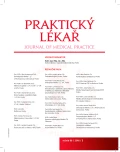-
Medical journals
- Career
Blepharoplasty – postoperative changes in subjective symptoms in patients
Authors: L. Zikmund
Authors‘ workplace: Pedagogická fakulta UJEP, Ústí nad Labem ; Děkan: doc. PaedDr. Pavel Doulík, Ph. D. ; Primářka: MUDr. Ivana Liehneová, Ph. D. ; Masarykova nemocnice, Oční klinika ; Krajská zdravotní a. s., Ústí nad Labem ; Vedoucí lékař: MUDr. Lukáš Zikmund ; Klinika MEDILAX, Ústí nad Labem
Published in: Prakt. Lék. 2016; 96(3): 141-148
Category: Of different specialties
Overview
Objective:
The author focuses on the analysis of the surgical technique blepharoplasty of upper and lower eyelids. Based and draws from his own experience, when he was allowed in the period 2005–2015 at an eye clinic and MEDILAX clinic personally perform 2904 blepharoplasties of the upper eyelids, and 1452 lower eyelid blepharoplasties in a total of 3257 patients.Methods:
This is a retrospective set of 3257 patients, who underwent in 2005–2015 upper blepharoplasty surgery (2904) or lower eyelids (1452). The surgery was performed in all patients under local anesthesia. Postoperative monitoring is planned for 3 weeks, 6 weeks and 3 months after surgery. The total number of patients outnumber men at a ratio of 85% to 15%. In the last 5 years from (2010 to 2015, set of 1817 patients) preoperative subjective complaints of patients were recorded in preoperative preparation. Specifically, it was a feeling of heavy, tired eyelids, increased lacrimation and recurrent swelling of the eyelids. The intention of monitoring is a subjective assessment of the improvements of observed parameters in patients after 3 weeks, 6 weeks and 3 months after surgery.Results:
The results obtained after evaluating patient response we confirm the positive effect not only on the aesthetic plane of surgery, but the surgery will significantly and positively influences the function of the eyelids and subjective feelings operated. All patients improved monitored parameters. The greatest benefit at 3 months after surgery were at the upper eyelid at 96.3% relief from the weary eyelids, tearing relief in 41.4%, with the lower lids of 94.2% disappearance of recurrent swelling of the eyelids.Conclusion:
The analysis confirms the positive impact of blepharoplasty on subjective complaints of the patient on an objective aesthetic and functional parameters. In the interest of the patient and in the interest of our operations is a positive result and mutual satisfaction while minimizing risk. If the patient has unrealistic ideas, and yet calls for performance that is not medically feasible, it is advisable that the patient is refused.Keywords:
blepharoplasty – surgery of the upper eyelids – lower eyelid surgery – fat prolapses
Sources
1. Bedrossian EH Jr. Reconstructive lower lid blepharoplasty. Ophthalmol Clin North Am 2005; 18(2): 291–300.
2. Berry EP. Planning and evaluating blepharoplasty. Plast Reconstr Surg 1974; 54(3): 257–264.
3. Cesneková T, Jurečka T, Skorkovská K, a kol. Rohovková ulcerace po operaci ptózy u pacienta s Kearns-Sayreovým syndromem. Čes. a slov. Oftal. 2011; 67(4): 133–135.
4. Ching S, Thoma A, McCabe RE, Antony MM. Measuring outcomes in aesthetic surgery: a comprehensive review of the literature. Plast Reconstr Surg 2003; 111(1): 469–482.
5. Cole RP, Shakespeare V, Shakespeare P, Hobby JA. Measuring outcome in low-priority plastic surgery patients using quality of life indices. Br J Plast Surg 1994; 47(2): 117–121.
6. de la Plaza R, Arroyo JM. A new technique for the treatment of palpebral bags. Plast Reconstr Surg 1988; 81(5): 677–685.
7. Floegel I, Horwath-Winter J, Muellner K, Haller-Schober EM. A conservative blepharoplasty may be a means of alleviating dry eye symptoms. Acta Ophthalmol Scand 2003; 81(3): 230–232.
8. Klassen A, Jenkinson C, Fitzpatrick R, Goodacre T. Patients’ health related quality of life before and after aesthetic surgery. Br J Plast Surg 1996; 49(7): 433–438.
9. de Lima CG, Siqueira GB, Cardoso IH, Sant’Anna AE. Evaluation of dry eye in the preoperative and postoperative period of blepharoplasty. Arq Bras Oftalmol 2006; 69(3): 377–382.
10. Loeb R. Fat pad sliding and fat grafting for leveling lid depressions. Clin Plast Surg 1981; 8(4): 757–776.
11. McCord, CD, Shore, JW. Avoidance of complications in lower lid blepharoplasty. Ophthalmology 1983; 90(9): 1039–1046.
12. Naik MN, Honavar SG, Das S, et al. Blepharoplasty: An overview. J Cutan Aesthet Surg 2009; 2(1): 6–11.
13. Rankin M, Borah GL, Perry AW, Wey PD. Quality-of-life outcomes after cosmetic surgery. Plast Reconstr Surg 1998; 102(6): 2139–2145.
14. Veiga DF, Veiga-Filho J, Ribeiro LM, et al. Quality-of-life and self-esteem outcomes after oncoplastic breast-conserving surgery. Plast Reconstr Surg 2010; 125(3): 811–817.
15. Viana GA, Osaki MH, Nishi M. Clinical outcomes, patients’ satisfaction and aesthetic results after lower eyelid blepharoplasty. Rev Col Bras Cir 2011; 38(5): 317–322.
16. Yelin JB, Clayton-Dyer BJ, Naderi A, Esmaeli B. Eyelid reconstruction: an oculoplastic surgeon’s perspective. Plast Surg Nurs 2001; 21(4): 192–195, 201.
Labels
General practitioner for children and adolescents General practitioner for adults
Article was published inGeneral Practitioner

2016 Issue 3-
All articles in this issue
- Larva migrans cutanea – an imported skin disease and possibilities of treatment
- Ankle brachial index and its interpretation in diabetic patients
- New oral anticoagulants – a review
- New impulse in cross-border healthcare
- Fine motor skills disorders in general practice
- Analysis of the therapeutic burden and the pilot presentation of results of CCC Prague
- Peripheral arterial disease
- Blepharoplasty – postoperative changes in subjective symptoms in patients
- General Practitioner
- Journal archive
- Current issue
- Online only
- About the journal
Most read in this issue- Fine motor skills disorders in general practice
- Larva migrans cutanea – an imported skin disease and possibilities of treatment
- Ankle brachial index and its interpretation in diabetic patients
- New oral anticoagulants – a review
Login#ADS_BOTTOM_SCRIPTS#Forgotten passwordEnter the email address that you registered with. We will send you instructions on how to set a new password.
- Career

